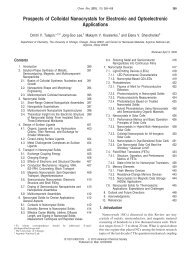FORWARD KINEMATICS: THE DENAVIT-HARTENBERG ...
FORWARD KINEMATICS: THE DENAVIT-HARTENBERG ...
FORWARD KINEMATICS: THE DENAVIT-HARTENBERG ...
Create successful ePaper yourself
Turn your PDF publications into a flip-book with our unique Google optimized e-Paper software.
78CHAPTER 3. <strong>FORWARD</strong> <strong>KINEMATICS</strong>: <strong>THE</strong> <strong>DENAVIT</strong>-<strong>HARTENBERG</strong> CONVENTION<br />
=<br />
=<br />
⎡<br />
⎢<br />
⎣<br />
⎡<br />
⎢<br />
⎣<br />
0<br />
0<br />
0<br />
⎤<br />
acθ<br />
asθ<br />
d<br />
⎡<br />
⎥ ⎢<br />
⎦ + d ⎣<br />
⎤<br />
⎤ ⎡ ⎤<br />
cθ<br />
⎥ ⎢ ⎥<br />
⎦ + a ⎣ ⎦ (3.20)<br />
0<br />
0<br />
1<br />
sθ<br />
0<br />
⎥<br />
⎦. (3.21)<br />
Combining the above results, we obtain (3.10) as claimed. Thus, we see<br />
that four parameters are sufficient to specify any homogeneous transformation<br />
that satisfies the constraints (DH1) and (DH2).<br />
Now that we have established that each homogeneous transformation<br />
matrix satisfying conditions (DH1) and (DH2) above can be represented<br />
in the form (3.10), we can in fact give a physical interpretation to each<br />
of the four quantities in (3.10). The parameter a is the distance between<br />
the axes z0 and z1, and is measured along the axis x1. The angle α is the<br />
angle between the axes z0 and z1, measured in a plane normal to x1. The<br />
positive sense for α is determined from z0 to z1 by the right-hand rule as<br />
shown in Figure 3.3. The parameter d is the distance between the origin<br />
xi<br />
zi<br />
αi zi−1<br />
xi−1<br />
xi<br />
Figure 3.3: Positive sense for αi and θi.<br />
zi−1<br />
O 0 and the intersection of the x1 axis with z0 measured along the z0 axis.<br />
Finally, θ is the angle between x0 and x1 measured in a plane normal to z0.<br />
These physical interpretations will prove useful in developing a procedure for<br />
assigning coordinate frames that satisfy the constraints (DH1) and (DH2),<br />
and we now turn our attention to developing such a procedure.<br />
θi
















